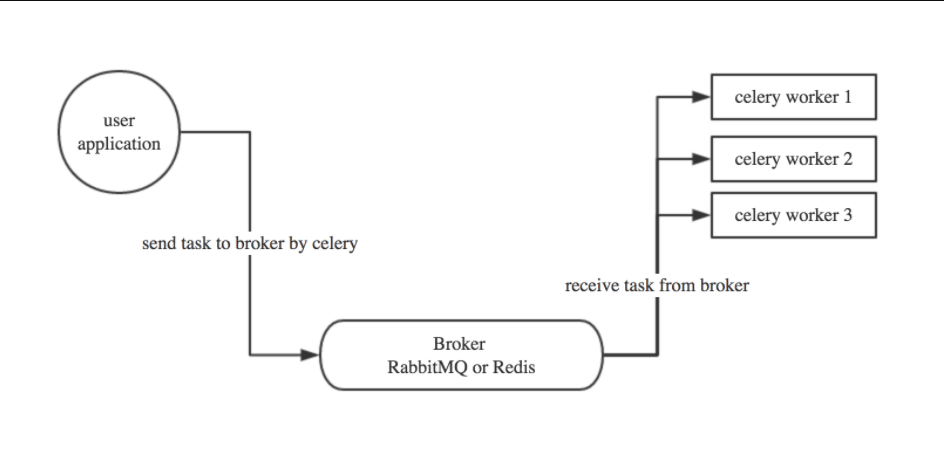介绍
celery 定时器是一个调度器(scheduler);它会定时地开启(kicks off)任务,然后由集群中可用的工人(worker)来执行。
定时任务记录(entries)默认 从 beat_schedule 设置中获取,但自定义存储也可以使用,如把记录存储到SQL数据库中。
要确保同一时间一份时间表上只有一个调度器在运行,否则会因为重复发送任务而结束。使用集中途径意味着定时任务不用必须同步,并且服务无需用锁操控。

- user:用户程序,用于告知celery去执行一个任务。
- broker: 存放任务(依赖RabbitMQ或Redis,进行存储)
- worker:执行任务
celery需要rabbitMQ、Redis、Amazon SQS、Zookeeper(测试中) 充当broker来进行消息的接收,并且也支持多个broker和worker来实现高可用和分布式。http://docs.celeryproject.org/en/latest/getting-started/brokers/index.html


Celery version 4.0 runs onPython ❨2.7, 3.4, 3.5❩PyPy ❨5.4, 5.5❩This is the last version to support Python 2.7, and from the next version (Celery 5.x) Python 3.5 or newer is required.If you’re running an older version of Python, you need to be running an older version of Celery:Python 2.6: Celery series 3.1 or earlier.Python 2.5: Celery series 3.0 or earlier.Python 2.4 was Celery series 2.2 or earlier.Celery is a project with minimal funding, so we don’t support Microsoft Windows. Please don’t open any issues related to that platform.
环境准备:
- 安装rabbitMQ或Redis
https://www.cnblogs.com/L5251/articles/9146825.html
https://www.cnblogs.com/L5251/articles/9325586.html
- 安装celery
pip3 install celery
快速上手


import time from celery import Celeryapp = Celery('tasks', broker='redis://192.168.10.48:6379', backend='redis://192.168.10.48:6379')@app.task def xxxxxx(x, y):time.sleep(10)return x + y
 s2.py
s2.py

from celery.result import AsyncResult from s1 import appasync = AsyncResult(id="f0b41e83-99cf-469f-9eff-74c8dd600002", app=app)if async.successful():result = async.get()print(result)# result.forget() # 将结果删除 elif async.failed():print('执行失败') elif async.status == 'PENDING':print('任务等待中被执行') elif async.status == 'RETRY':print('任务异常后正在重试') elif async.status == 'STARTED':print('任务已经开始被执行')
# 执行 s1.py 创建worker(终端执行命令): celery worker -A s1 -l info # PS:Windows系统上执行命令时出错解决方法 pip3 install eventlet # 后期运行修改为:celery worker -A s1 -l info -P eventlet # 执行 s2.py ,创建一个任务并获取任务ID: python3 s2.py# 执行 s3.py ,检查任务状态并获取结果:python3 s3.py
多任务结构
pro_cel├── celery_tasks# celery相关文件夹│ ├── celery.py # celery连接和配置相关文件│ └── tasks.py # 所有任务函数├── check_result.py # 检查结果└── send_task.py # 触发任务


#!/usr/bin/env python # -*- coding:utf-8 -*- from celery import Celerycelery = Celery('xxxxxx',broker='redis://192.168.0.111:6379',backend='redis://192.168.0.111:6379',include=['celery_tasks.tasks'])# 时区 celery.conf.timezone = 'Asia/Shanghai' # 是否使用UTC celery.conf.enable_utc = False


#!/usr/bin/env python # -*- coding:utf-8 -*-import time from .celery import celery@celery.task def xxxxx(*args, **kwargs):time.sleep(5)return "任务结果"@celery.task def hhhhhh(*args, **kwargs):time.sleep(5)return "任务结果"


#!/usr/bin/env python # -*- coding:utf-8 -*-from celery.result import AsyncResult from celery_tasks.celery import celeryasync = AsyncResult(id="ed88fa52-11ea-4873-b883-b6e0f00f3ef3", app=celery)if async.successful():result = async.get()print(result)# result.forget() # 将结果删除 elif async.failed():print('执行失败') elif async.status == 'PENDING':print('任务等待中被执行') elif async.status == 'RETRY':print('任务异常后正在重试') elif async.status == 'STARTED':print('任务已经开始被执行')


#!/usr/bin/env python # -*- coding:utf-8 -*- import celery_tasks.tasks# 立即告知celery去执行xxxxxx任务,并传入两个参数 result = celery_tasks.tasks.xxxxx.delay(4, 4)print(result.id)
更多配置:http://docs.celeryproject.org/en/latest/userguide/configuration.html
定时任务
1. 设定时间让celery执行一个任务
import datetime from celery_tasks.tasks import xxxxx """ from datetime import datetimev1 = datetime(2017, 4, 11, 3, 0, 0) print(v1)v2 = datetime.utcfromtimestamp(v1.timestamp()) print(v2)""" ctime = datetime.datetime.now() utc_ctime = datetime.datetime.utcfromtimestamp(ctime.timestamp())s10 = datetime.timedelta(seconds=10) ctime_x = utc_ctime + s10# 使用apply_async并设定时间 result = xxxxx.apply_async(args=[1, 3], eta=ctime_x) print(result.id)
2. 类似于contab的定时任务
""" celery beat -A proj celery worker -A proj -l info""" from celery import Celery from celery.schedules import crontabapp = Celery('tasks', broker='amqp://47.98.134.86:5672', backend='amqp://47.98.134.86:5672', include=['proj.s1', ]) app.conf.timezone = 'Asia/Shanghai' app.conf.enable_utc = Falseapp.conf.beat_schedule = {# 'add-every-10-seconds': {# 'task': 'proj.s1.add1',# 'schedule': 10.0,# 'args': (16, 16)# },'add-every-12-seconds': {'task': 'proj.s1.add1','schedule': crontab(minute=42, hour=8, day_of_month=11, month_of_year=4),'args': (16, 16)}, }
注:如果想要定时执行类似于crontab的任务,需要定制 Scheduler来完成。
Flask中应用Celery
pro_flask_celery/
├── app.py
├── celery_tasks├── celery.py└── tasks.py 

#!/usr/bin/env python # -*- coding:utf-8 -*-from flask import Flask from celery.result import AsyncResultfrom celery_tasks import tasks from celery_tasks.celery import celeryapp = Flask(__name__)TASK_ID = None@app.route('/') def index():global TASK_IDresult = tasks.xxxxx.delay()# result = tasks.task.apply_async(args=[1, 3], eta=datetime(2018, 5, 19, 1, 24, 0))TASK_ID = result.idreturn "任务已经提交"@app.route('/result') def result():global TASK_IDresult = AsyncResult(id=TASK_ID, app=celery)if result.ready():return result.get()return "xxxx"if __name__ == '__main__':app.run()


#!/usr/bin/env python # -*- coding:utf-8 -*- from celery import Celery from celery.schedules import crontabcelery = Celery('xxxxxx',broker='redis://192.168.10.48:6379',backend='redis://192.168.10.48:6379',include=['celery_tasks.tasks'])# 时区 celery.conf.timezone = 'Asia/Shanghai' # 是否使用UTC celery.conf.enable_utc = False


#!/usr/bin/env python # -*- coding:utf-8 -*-import time from .celery import celery@celery.task def hello(*args, **kwargs):print('执行hello')return "hello"@celery.task def xxxxx(*args, **kwargs):print('执行xxxxx')return "xxxxx"@celery.task def hhhhhh(*args, **kwargs):time.sleep(5)return "任务结果"
记录
为了定时调用任务,你必须添加记录到打点列表中:
from celery import Celery from celery.schedules import crontabapp = Celery()@app.on_after_configure.connect def setup_periodic_tasks(sender, **kwargs):# 每10秒调用 test('hello') .sender.add_periodic_task(10.0, test.s('hello'), name='add every 10')# 每30秒调用 test('world') sender.add_periodic_task(30.0, test.s('world'), expires=10)# 每周一上午7:30执行 sender.add_periodic_task(crontab(hour=7, minute=30, day_of_week=1),test.s('Happy Mondays!'),)@app.task def test(arg):print(arg)
用on_after_configure处理器进行这些设置意味着当使用test.s()时我们不会在模块层面运行app 。
add_periodic_task() 函数在幕后会添加记录到beat_schedule设定,同样的设定可以用来手动设置定时任务:
例子: 每30秒运行 tasks.add .
app.conf.beat_schedule = {'add-every-30-seconds': {'task': 'tasks.add','schedule': 30.0,'args': (16, 16)}, } app.conf.timezone = 'UTC'
一般会使用配置文件进行配置,如下
celeryconfig.py:
broker_url = 'pyamqp://' result_backend = 'rpc://'task_serializer = 'json' result_serializer = 'json' accept_content = ['json'] timezone = 'Europe/Oslo' enable_utc = True beat_schedule = {'add-every-30-seconds': {'task': 'tasks.add','schedule': 30.0,'args': (16, 16)}, }
程序里使用:
app.config_from_object('celeryconfig')注意 如果你的参数元组里只有一个项目,只用一个逗号就可以了,不要圆括号。
时间表使用时间差意味着每30秒间隔会发送任务(第一个任务在celery定时器开启后30秒发送,然后上每次距一次运行后30秒发送一次)
可使用的属性
-
task
要执行的任务名字
-
schedule
执行的频率
可以是整数秒数,时间差,或者一个周期( crontab)。你也可以自 定义你的时间表类型,通过扩展schedule接口。
-
args
位置参数 (list 或 tuple).
-
kwargs
键值参数 (dict).
-
options
执行选项 (dict).
这可以是任何被apply_async()支持的参数与—-exchange, routing_key, expires,等。
-
relative
如果 relative 是 true ,时间表“由时钟时间”安排,意味着 频率近似到最近的秒,分钟,小时或天,这取决于时间差中的时间间隔。
默认relative是false,频率不会近似,会相对于celery的启动时间。Crontab 表达式语法非常灵活。
-
| 例子 | 含义 |
|---|---|
| crontab() | 每分钟执行 |
| crontab(minute=0, hour=0) | 每天午夜执行 |
| crontab(minute=0, hour=’*/3’) | 每三个小时执行: 午夜, 3am, 6am, 9am, 正午, 3pm, 6pm, 9pm. |
| crontab(minute=0,hour=’0,3,6,9,12,15,18,21’) | 同上 |
| crontab(minute=’*/15’) | 每15分钟执行 |
| crontab(day_of_week=’sunday’) | 星期日每分钟 |
| crontab(minute=’‘,hour=’‘, day_of_week=’sun’) | 同上 |
| crontab(minute=’*/10’,hour=’3,17,22’, day_of_week=’thu,fri’) | 每10分钟执行,仅限于周六日3-4 am, 5-6 pm, and 10-11 pm |
| crontab(minute=0, hour=’/2,/3’) | 偶数小时或者能被3整除的小时数执行 |
| crontab(minute=0, hour=’*/5’) | 被5整除的小时数,如3pm |
| crontab(minute=0, hour=’*/3,8-17’) | 8am-5pm能被3整除的 |
| crontab(0, 0, day_of_month=’2’) | 每月第2天 |
| crontab(0, 0,day_of_month=’2-30/3’) | 每偶数天 |
| crontab(0, 0,day_of_month=’1-7,15-21’) | 每月1和3周 |
| crontab(0, 0, day_of_month=’11’,month_of_year=’5’) | 每年5月11日 |
| crontab(0, 0,month_of_year=’*/3’) | 每个季度第1月 |
开启调度
开启celery定时服务:
$ celery -A proj beat
可以把定时器嵌入到工人(worker)中,通过启用workers -B选项,如果你永远不会运行超过一个工人节点这就会很方便。但这不太常见,不推荐在生产环境这样使用:
$ celery -A proj worker -B
定时器需要在本地数据库文件(默认名为 celerybeat-schedule )存储任务上次运行时间,所以它需要在当前目录中写权限。或者你也可以给这个文件指定一个位置:
$ celery -A proj beat -s /home/celery/var/run/celerybeat-schedule
)
)
Chrome的下载设置)


)



使用方法)









